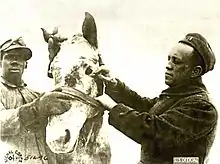Mallein test
The mallein test is a sensitive and specific clinical test for glanders, a common bacterial disease of equids (horses, donkeys, mules).[1] This test is an allergic hypersensitivity test used as a diagnosis for glanders.[1] It is caused by a bacterium called Burkholderia mallei, which is contagious for humans and other species.[1] The occurrence of glanders must be reported to the World Organisation for Animal Health.[1] Mallein, a protein fraction of B. mallei, is usually injected by an eye-drop. If an animal is infected, the animal will show swelling in the eye from around 48 hours of injection and may be accompanied by secretion and conjunctivitis.[2] Mallein is non toxic to normal animals.[3]

History
Mallein was discovered in 1890 [4] [3] by Kristaps Helmanis and Oto Kalninš.[5] ˇBefore 1934, glanders was widespread. In the early 1900s, glanders was common in Europe, the United States of America, and Canada, and has been successfully eliminated by mass testing and the slaughter and destruction of campaigns.[1] Glanders is still present in Asia, the Middle East and South America.[2]
Limitations and benefits
Limitations
Although Mallein is the most commonly used form of testing for glanders, cross reactions were reported between Burkholderia mallei and Streptococcus equi,[1] which is a bacteria-caused contagious upper respiratory tract infection of equines. This resulted in false-positive reactions.[1]
Test procedures and methods
- Preparation of crude mallein[4]
- Purification of malleo proteins[4]
- Trichloroacetic acid (TCA) preparation[4]
- Ammonium sulfate precipitation[4]
- Gel filtration chromatography[4]
- Sensitization of animals[4]
- Potency test[4]
- Intradermopalpebral[4]
See also
References
- Naureen A, Saqib M, Muhammad G, Hussain MH, Asi MN (July 2007). "Comparative evaluation of Rose Bengal plate agglutination test, mallein test, and some conventional serological tests for diagnosis of equine glanders". J. Vet. Diagn. Invest. 19 (4): 362–7. doi:10.1177/104063870701900404. PMID 17609344.
- de Carvalho Filho MB, Ramos RM, Fonseca AA, de Lima Orzil L, Sales ML, de Assis Santana VL, de Souza MM, Dos Reis Machado E, Filho PR, Leite RC, Dos Reis JK (September 2012). "Development and validation of a method for purification of mallein for the diagnosis of glanders in equines". BMC Vet. Res. 8: 154. doi:10.1186/1746-6148-8-154. PMC 3514244. PMID 22937975.
- Hagebock JM, Schlater LK, Frerichs WM, Olson DP (January 1993). "Serologic responses to the mallein test for glanders in solipeds". J. Vet. Diagn. Invest. 5 (1): 97–9. doi:10.1177/104063879300500121. PMID 8466990.
- Verma RD, Venkateswaran KS, Sharma JK, Agarwal GS (August 1994). "Potency of partially purified malleo-proteins for mallein test in the diagnosis of glanders in equines". Vet. Microbiol. 41 (4): 391–7. doi:10.1016/0378-1135(94)90035-3. PMID 7801539.
- Susan D. Jones, Peter A. Koolmees. A Concise History of Veterinary Medicine. Cambridge University Press, p. 190, ISBN 9781108354929
External links
 Media related to Mallein test at Wikimedia Commons
Media related to Mallein test at Wikimedia Commons